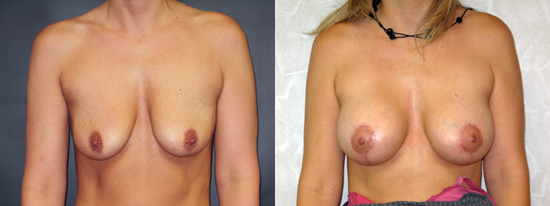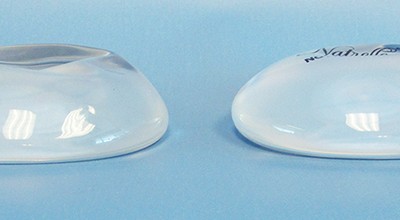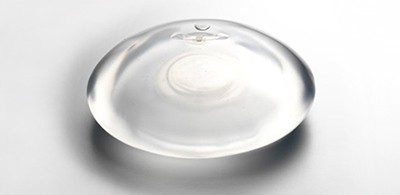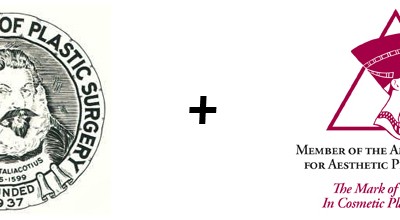
Breast Augmentation and Breast Lift
Augmentation Mastopexy
In situations where there is a lack of breast volume and loose breast skin, augmentation of the breasts with implants in conjunction with a breast lift may be desirable; but that is entirely a personal decision. A woman’s primary objective is an important factor in determining what type of operation is performed. Some women are primarily interested in breast augmentation while others express more interest in a breast lift. For patients who consider augmentation to be their primary goal, the breast implant should be just large enough to allow the breast to achieve the desired shape. The remaining skin laxity is then reduced and tightened around the augmented breast. Combined breast augmentation and mastopexy can be performed with saline- or silicone gel-filled breast implants placed in the subglandular or subpectoral position.
When performing augmentation mastopexy, subglandular implant placement may be advantageous because this implant position contributes more directly to nipple-areolar projection. However, a subglandular implant may assume a lower position than one placed in the subpectoral space. A subglandular position also necessitates the use of a silicone implant to reduce the risk for implant palpability and surface rippling. In obviously hypotrophic breasts, with minimal breast tissue and thin lax skin, there is a lack of adequate soft tissue covering to mask the implants necessitating subpectoral placement. In a subpectoral position either a saline- or silicone gel-filled implant may be used.
The degree of breast ptosis remains an important factor in the surgical decision making process, but the nipple position on the breast mound and the relationship of the breast gland to the inframammary fold are also important factors when considering a mastopexy. The more the breast gland overhangs the inframammary fold, the more difficult it is for the implant to fill out the breast adequately without adjusting the skin envelope at the same time. The lower the nipple sits on the breast, the less likely it is that the placement of the implant will shift the nipple superiorly enough on the breast to achieve an acceptable aesthetic result. Implant volume introduces another variable; a larger volume implant may reduce breast skin redundancy and the amount of lift required, but no implant will ever lift a sagging breast or drooping nipple-areolar complex.
However, it is important to remember that the answer to excessive breast skin laxity is not a larger implant. A breast lift combined with an augmentation works better when the implant fills out most of the available skin envelope but leaves enough excess skin to reshape the breast and reposition the nipple. Better results will be achieved with a moderate augmentation and a lift, including better implant positioning, improved breast shape, and reduced effects of implant size and weight on the breast tissue and (already damaged) skin.
Combining breast augmentation and breast lift, in the same operation, can make for technically-demanding surgery that presents special problems. The purpose is to perform two operations on the breast, which have conflicting goals, at the same time. The purpose of a breast augmentation is to enlarge the breast, which involves stretching the skin of the breast and the areola. A breast lift is designed to reduce the areola and tighten the breast skin envelope. The variables associated with the conflicting goals of these two procedures, and the potential for later changes from each, may cause intraoperative difficulty and postoperative disappointment.
For these reasons, there are a few situations where a staged approach may offer better results. Although most women prefer a single, combined procedure, it may be wise to stage the two operations because more control is achieved with each individual procedure – a breast lift is performed first and allowed to heal, and the augmentation is performed several months later.
The results of combining breast lift and augmentation are less predictable than those associated with either procedure alone. Large volume implants certainly place additional stress on what is usually an already compromised skin envelope. Disappointments related to final scar position, nipple position, implant position, or breast shape may occur. More common problems include migration of the inframammary scar superiorly or some misalignment between the nipple, breast, and/or implant. It is not unusual for a minor revision to be necessary for some patients several months or years later; revision may involve repositioning of the implant, scars, or areola.
NEXT TOPIC: Breast Implant Failure
What is the Gel-to-Shell Fill Volume Ratio?
Each round silicone gel-filled breast implant is comprised of a silicone elastomer shell which contains the silicone gel filling. Silicone gel breast implants are filled by the manufacturer with a moderately cohesive (responsive) silicone gel. If you look carefully at...
How Firm is a Saline Breast Implant?
During the consultation today, a patient asked me, "Aren't saline implants harder?" Well, it actually depends. Let me start by saying that if you have ever held a saline implant and a silicone gel implant side-by-side, you know that they feel completely different, and...
Why is a board certified plastic surgeon important for my breast augmentation?
I recently saw a woman in consultation for a failed saline breast implant. She had her breast augmentation performed seven years earlier by a surgeon who advertises like a plastic surgeon, but is not board certified in plastic surgery. And as far as I am aware, has...




